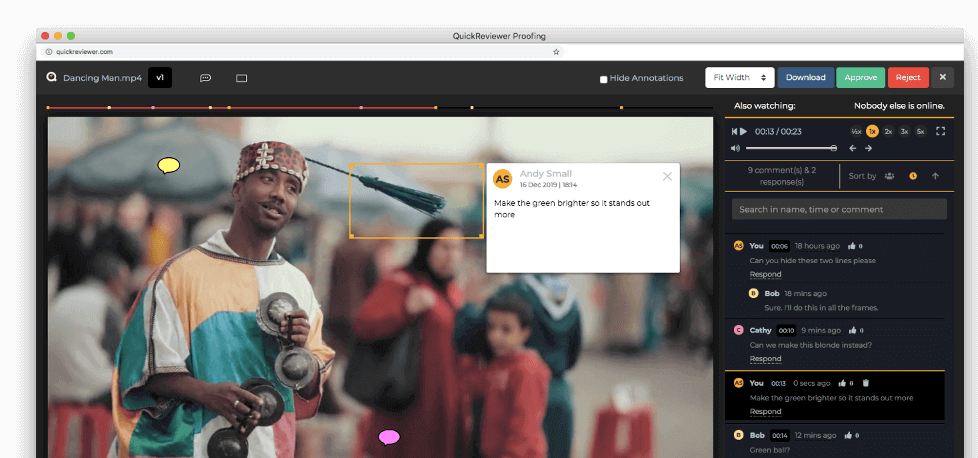What is Online Proofing: Online proofing is a word that refers to the secure process of evaluating and approving creative work through the use of an internet workflow, which is usually powered by online proofing softwares. Before online proofing, creative and marketing teams had to approve their design work using either printed paper-based techniques or long-tail email chains, which was inconvenient and time-consuming.
You may approve creative work in digital and printed form in a more efficient, transparent, and manageable manner using an online proofing process. It removes crucial technological and practical hurdles to development, making the environment more participatory. By simplifying your input and approval procedures, online proofing might help you save time and money. Additionally, it increases creative production without wasting time. It’s a cutting-edge online approval system that you may use from anywhere.
Steps To Achieve Successful Online Proofing:
Below are a few steps for successful online proofing.
- THE CONTENT
Once the team has completed the first creative assignment, the first stage is to compile the content you wish to submit for proof. The online proofreading process can be set in the following phases based on the file path and online proofing technologies you employ.
- SENDING PROOFS FOR REVIEW
These are a few ways to share content for online proofing.
Export file uploader:
This is the most straightforward way to upload and export files. It’s done by going to files on a local workstation or network, as well as in a cloud system like Dropbox, and then uploading them to the proofing internet portal. It’s the most simple method for submitting export files or documents for evaluation, such as PDFs.
Direct from Adobe Creative Cloud:
To create creative work, most graphic designers and content creators utilize Adobe apps like InDesign, Premiere Pro, or Photoshop. Proofs can be shared directly from these apps utilizing extensions or plugins developed by the online proofing software provider, bypassing the time-consuming procedure of exporting files into another format and then utilizing the file uploader.
The software’s interface will walk you through the process of sharing your work. Establishing deadlines, adding files, enabling copy modifications, forming teams of contributors, adding personalized messages, and other features may be available depending on the product. Upon completion of this process all the collaborators receive notifications with a secure link to the proof shared.
- ASSIGNMENT OF COLLABORATOR ROLES
The review process of any creative team requires clarity on who has what duties. These duties include commenting, copy editing, inviting new colleagues, requesting changes, submitting files, and signing off work.
Online proofreading facilitates this by allowing the sender to assign roles to collaborators and having the software handle their obligations. The role structure must include these persons.
Observer
Someone who can look at proofs but not remark on them or participate in the discourse.
Reviewer
Someone who can look at proofs, comment on them, @mention other people, and upload files.
Gatekeeper
The person in charge, who shares the same profile as a Reviewer but has the authority to add new collaborators, request changes for new versions, and sign off on proofs.
Collaborator roles are critical for keeping reviews on track and guaranteeing total accountability throughout the creative process.
- PROOFING & COLLABORATION
One of the most major advantages of online proofing is that instead of many copies being disseminated via emails or printouts, there is only one proof that everyone views and comments on.
The proofing interface, which is maintained securely on the web and available through a browser or mobile app, may vary in terms of functionality and look, but its main objective is to make it as easy as possible for collaborators to review the proof and provide feedback. It’s vital to give collaborators the best tools for sharing their thoughts and providing accurate comments.
Designers may then see exactly what the flaw is and, more importantly, where it appears on the proof. A proofing system’s collaboration zone offers elements like collaborator status, comments, copy editing, file sharing, and so on.
- RECEIVING CHANGE REQUESTS
Designers may get feedback from reviewers and act on it in two ways, similar to how they exchange and send proofs out for examination. The first is the collaboration zone, where designers keep track of comments posted on proofs and determine what has to be done. They begin working on the source file when a proof has been requested for a new version to be made, referencing the proofing application throughout the process.
The second option is to use their Adobe programmes directly. Using an extension that resides inside the Adobe software, creative designers may access all comments, changes, and files immediately into their document or video side panel. They won’t have to leave Creative Cloud to read the feedback, and they’ll be able to see it page by page in context. They can just press ‘Apply’ to make copy changes to the document. It saves you hours of rework time.
- SENDING NEW VERSIONS
It’s critical to select an online proofing software supplier that doesn’t limit the amount of proofs you can send out to promote maximum cooperation returns, because the creative designers create a new version of the proof inside their design programme and then share it for the next review round. By remembering the settings from the previous review, online proofing softwares assists to simplify the new version sharing process. Useful automations like adding the contributors and giving the evidence a new version number can make it easier to track. In addition, reporting engines give insights to assist creative teams in evaluating how much time is spent on revisions and rework, which may be utilized to compare output to projected time.
- FINAL APPROVAL
Signing off on a proof may usually only be done by a collaborator who has been assigned the right role in order to prevent the proof from being published without the proper permission or authority. Also collaborators should be able to monitor and keep track of their reviews throughout the process.
Take Away:
Online proofing helps speed up the input and approval procedures for the content. It also allows numerous team members to view, review, and discuss digital media like videos, photos, graphics, layouts, audios, labels etc on any device and from any place at the same time. Hence it improves the collaboration and communication in the team.
Furthermore, online proofing removes email approvals, eliminates other conventional methods of managing approval procedures, avoids excessive revisions, provides transparency, stimulates responsibility, and so on. Businesses could employ online proofing tools such as GoVisually, Ziflow, zipBoard, GoProof, ReviewStudio, ProofHub, PageProof, and others to make their approval process easier and more controllable,
Some other Posts you might be interested in.
Empowering Success: Inspiring Design and Marketing Campaigns Led by Women Changing the Game
In the dynamic worlds of design and marketing, women have been instrumental in shaping groundbreaking campaigns that captivate audiences and drive meaningful change. From challenging stereotypes to championing inclusivity, their creativity and strategic vision have...
Top 5 Team Collaboration Tools—Which One Do You Choose as A Creative Agency?
Effective collaboration is the lifeblood of modern businesses. Organisations are turning to team collaboration tools to streamline workflows, improve productivity, and enhance communication among team members. Collaboration in the workplace is the cornerstone of...
How does knowledge management boost creative collaboration?
What is knowledge management? Knowledge management refers to an organization's or team's capacity to work together toward a common goal. Knowledgebase management encourages teams to go outside the box when developing methods for attaining their goals. It's a...




